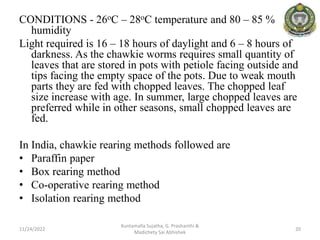
Imagine you’re in a cozy space where the air is just right—not too hot and not too cold, just like Goldilocks would prefer. **Silkworms** are quite particular about their living conditions. If you’re considering starting a silkworm farm, understanding their temperature and humidity needs is essential for a successful harvest. So, grab a cup of coffee, and let’s break it down together.
The Basics of Silkworm Farming
Before we get into the nitty-gritty of temperature and humidity, it’s important to grasp what silkworms are and why they’re so valuable. Silkworms, or *Bombyx mori*, are the larvae of the silk moth. They’ve been cultivated for thousands of years for their silk, which is woven into beautiful fabrics. Rearing them isn’t just about providing food; it’s about creating an ideal habitat.
Here’s the thing: silkworms go through several life stages, from egg to larva to pupa. Each stage has its own requirements, and if you want them to grow big and strong enough to spin cocoons, you’ve got to pay attention to their environment. It’s all about balancing the right **temperature** and **humidity** to ensure they thrive.
Ideal Temperature for Silkworms
Silkworms are happiest within a specific temperature range. Generally, **25°C to 28°C (77°F to 82°F)** is ideal during their larval stage. This is like their sweet spot—a cozy warm room that keeps them comfortable and active.
If the temperature dips below 20°C (68°F), these worms can become sluggish. Think of it like a chilly day when you just want to curl up under a blanket. Conversely, if it rises above 30°C (86°F), they might get stressed, which can lead to undesirable outcomes, like stunted growth or even death. So, here’s a simple rule: keep them warm but not too hot.
To achieve this, many farmers use heaters or air conditioning, depending on the season. Regular checks with a thermometer can help maintain a steady climate. You might consider setting reminders to check regularly, especially during seasonal changes.
Humidity Levels for Silkworm Rearing
Next up is **humidity**, which is just as crucial as temperature. Silkworms need a humidity level of around **60% to 85%** during their larval stage to stay in good health. This moisture aids in their growth and helps prevent diseases.
Low humidity can lead to dehydration, causing silkworms to shrivel up—definitely not the look you want for your future silk producers! On the other hand, high humidity can encourage mold and bacteria, which can wipe out an entire batch. Finding this balance can feel like walking a tightrope, but it’s essential for your silkworms’ welfare.
To manage humidity, using a hygrometer can be super helpful. This little device will let you know whether that air is just right or if it needs adjusting. You might also want to mist the area lightly or use humidifiers if the air is too dry.
Creating the Perfect Environment
Now that we’ve covered temperature and humidity individually, let’s talk about how to create that perfect environment for your silkworms. It’s about combining the two for a cozy setup that would make any little silkworm happy.
Start by choosing a location that’s away from direct sunlight, drafts, or extreme temperature fluctuations. Basements or specially designed silkworm rearing houses often make great spaces because they can maintain stable conditions.
Consider using **air conditioning units or heaters** equipped with a thermostat to maintain your desired temperature. Additionally, a **humidifier** will help keep the moisture levels just right. Remember to check both temperature and humidity often, making adjustments as needed. Keeping a log can help you spot any patterns over time, and you’ll become a pro in no time.
Common Problems You Might Face
Even with the best intentions, issues can pop up when rearing silkworms. One common problem is fluctuations in temperature and humidity. Maybe your heater runs out of fuel, or you forget to refill the humidifier. These are moments that can lead to stress for your silkworms, impacting their growth and silk production.
If you notice your silkworms becoming sluggish or if you see some dying, think back to their environment. Are the temperatures too low or high? Is the humidity within the recommended range? Swiftly addressing these conditions can make all the difference.
You can also lose silkworms to diseases if hygiene isn’t kept up. Regularly clean their environment, removing any uneaten food or waste. This practice helps prevent fungal infections, which can thrive in damp conditions.
Monitoring Environmental Conditions
To keep things on track, monitoring is key. You might be wondering how you can effectively keep tabs on both temperature and humidity without becoming overwhelmed.
One straightforward method is to use **digital temperature and humidity monitors**. These tools give you real-time readings and can send alerts if conditions stray from your set parameters. Some come with data logging features, allowing you to review conditions over time.
If you prefer a low-tech approach, you can always check manually. A simple thermometer and hygrometer duo can work wonders. Just remember to check these readings multiple times a day—especially during seasonal changes.
Raising silkworms can be a rewarding endeavor, especially when you understand how vital **temperature and humidity** are to their health and productivity. By setting up a cozy environment that maintains around **25°C to 28°C** and a humidity of **60% to 85%**, you set the stage for a thriving silkworm farm.
Remember, keeping a close eye on their conditions and being ready to make adjustments will lead to successful rearing. With care and attention, you’ll see those little silkworms flourish, turning into the source of beautiful silk. So, go ahead and take the plunge into silkworm rearing—your future silk production might just become your new passion project!
